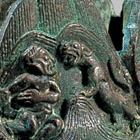J.J. Lally & Co., Oriental Art / New York City, New York
MenuPast Exhibition
Ancient Chinese Bronzes
March 19 - April 9, 2011
15.
AN ARCHAIC BRONZE HILL CENSER (BOSHANLU)
Han Dynasty (206 B.C. – A.D. 220)
the pierced cover elaborately cast in the form of a mountain with groves of trees and numerous figures and animals in relief, the stylized cliffs rising to a central peak, with apertures behind the cliffs to allow the incense smoke to emerge, the figures and animals including a monkey, a mountain-sprite thrusting his spear at a rearing tiger, a man hunting with bow and arrow, a phoenix, a traveler with a donkey cart, a tiger attacking a unicorn, another mountain-sprite confronting a tiger, and a hound pursuing several deer, the edge of the cover fitted over the raised inner rim of the bowl-form censer, on a short cylindrical standard with spreading circular foot decorated with three stylized dragons in relief, the surface with scattered green and red patination overall.
Height 7 1⁄2 inches (19 cm)
The boshanlu was an innovation of the Western Han. The elaborate imagery of the cover is a depiction of the ‘sacred mountains’, which were regarded in Han cosmology as an intermediary realm between heaven and earth. The high peaks of the ‘sacred mountains’ were a magic place where men encountered spirits and mythical beasts amidst the clouds.
The term boshanlu can be traced back to the 4th century or earlier, but no particular Bo mountain can be identified in Chinese literature or geography, and the specific origins of the term remain a mystery. One traditional Chinese explanation is that the censer represents Mount Hua. It is said that the King Zhao of Qin challenged the heavenly spirits to a game of liubo on Mount Hua, and so in honor of this event, the mountain was given the name of Bo Mountain (shan). Berthold Laufer suggested that the mountain represents Penglai, the magical realm of the Daoist Immortals. It has also been suggested that the mountain represents Kunlun, the cosmic mountain of China which was said to exist in a range of mystical mountains northwest of the Chinese frontier.
A Western Han bronze boshanlu of similar form and design in the Harold and Arlene Schnitzer Collection is illustrated by Jenkins, Mysterious Spirits, Strange Beasts, Earthly Delights, Portland Art Museum, Oregon, 2005, pp. 26-27.
For a detailed discussion of the imagery and cosmology embodied in this type of censer, see Sacred Mountains in Chinese Art by Munakata, University of Illinois Press, Urbana, 1991, where the author illustrates a Han bronze mountain-form censer lid of very similar design from the Chicago Field Museum of Natural History, p. 73, no. 18, and refers to two other more elaborate versions of closely related design, one excavated in 1968 from the tomb of princess Dou Wan of Zhongshan in Mancheng, Hebei, dated to 118-104 B.C., and the other in the Freer Gallery of Art, Washington D.C. The author goes on to say that the shared iconography and quality of casting indicates that these censers “…were made in the imperial workshop or in the workshops closely related to it.”
漢 銅博山爐
高 19 厘米
